Kristine Hughes's Blog, page 116
December 26, 2012
Boxing Day
 From The Book of Christmas: Descriptive of the Customs, Ceremonies, Traditions ... By Thomas Kibble Hervey (1845) ST. STEPHEN'S DAY - 26TH DECEMBER This day—which, in our calendar, is still dedicated to the first Christian martyr, St. Stephen (for John the Baptist perished in the same cause, before the consummation of the old law, and the full introduction of the Christian dispensation),—is more popularly known by the title of Boxing-day; and its importance, amongst the Christmas festivities, is derived from the practice whence that title comes. We have already mentioned that the custom of bestowing gifts, at seasons of joyous commemoration, has been a form of thankfulness at most periods ;—and that it may have been directly borrowed, by the Christian worshippers, from the Polytheists of Rome, along with those other modes of celebration which descended to the Christmas festival, from that source,—introduced, however, amongst our own observances, under scripture sanctions, drawn both from the Old and New Testaments. The particular form of that practice, whose donations are known by the title of Christmas-boxes (and which appear to differ from New-year's gifts in this,—that the former, passing from the rich to the poor, and from the master to his dependants, are not reciprocal in their distribution,—whereas the latter are those gifts, for the mutual expression of good-will and congratulation, which are exchanged between friends and acquaintances), was, perhaps, originally one of the observances of Christmas-day, and made a portion of its charities. The multiplied business of that festival, however, probably caused it to be postponed till the day following,—and thereby placed the Christmas-boxes under the patronage of St. Stephen. The title itself has been derived, by some, from thebox which was kept on board of every vessel that sailed upon a distant voyage, for the reception of donations to the priest; who, in return, was expected to offer masses for the safety of the expedition, to the particular saint having charge of the ship—and, above all, of the box. This box was not to be opened till the return of the vessel; and we can conceive that, in cases where the mariners had had a perilous time of it, this casket would be found to enclose a tolerable offering. Probably the state of the box might be as good an evidence as the log-book, of the character of the voyage which had been achieved. The mass was, at that time, called Christmass;—and the boxes kept to pay for it were, of course, called Christmass-boxes. The poor, amongst those who had an interest in the fate of these ships,—or of those who sailed in them,—were in the habit of begging money from the rich, that they might contribute to the mass boxes; and hence the title which has descended to our day:—giving to the anniversary of St. Stephen's martyrdom the title of Christmas-boxing day— and, by corruption, its present popular one of Boxing-day. A relic of these ancient boxes yet exists, in the earthen or wooden box, with a slit in it, which still bears the same name; and is carried, by servants and children, for the purpose of gathering money, at this season—being broken only when the period of collection is supposed to be over. Most of our readers know that it was the practice, not many years ago (and in some places is so still), for families to keep lists of the servants of tradesmen and others, who were considered to have a claim upon them for a Christmas-box at this time. The practice,—besides opening a door to great extortion,—is one, in every way, of considerable annoyance,—and is on the decline. There is, however,—as they who are exposed to it know,—some danger in setting it at defiance, where it is yet in force. One of the most amusing circumstances, arising out of this determination to evade the annoyances of Boxing-day, is related by Sandys. A person in trade had imprudently given directions that he should be denied, on this day, to all applicants for money; and amongst those who presented themselves at his door, on this errand, was, unfortunately, a rather importunate creditor. In the height of his indignation, at being somewhat uncourteously repulsed, he immediately consulted his lawyer; and, having done that, we need scarcely relate the catastrophe. It follows, as a matter of course. A docket was struck against the unsuspecting victim of Christmas-boxophobia. Boxing-day, however, is still a great day, in London. Upon this anniversary, every street resounds with the clang of hall-door knockers. Rap follows rap, in rapid succession,—the harsh and discordant tones of iron mingling with those of rich and sonorous brass, and giving a degenerate imitation of the brazen clangor of the trumpet which formed the summons to the gate, in days of old,—and which, together with the martial music of the drum, appears to have been adopted, at a later period, by the Christmasboxers, on St. Stephen's-day. Pepys, in his diary (1668), records his having been "called up by drums and trumpets;—these things and boxes," he adds, "have cost me much money, this Christmas, and will do more." Which passage seems to have been in the memory of our facetious publisher, when he made the following entry in his journal of last year,—from whence we have taken the liberty of transcribing it.—" Called out," says Spooner (1834), "by the parish beadle, dustmen, and charity-boys. The postman, street-sweepers, chimney-sweepers, lamp-lighters, and waits, will all be sure to wait upon me. These fellows have cost me much money this Christmas,—and will do more, the next." There is an amusing account, given by a writer of the querulous class, of a boxing-day, in London, a century ago. "By the time I was up," says he, "my servants could do nothing but run to the door. Inquiring the meaning, I was answered, the people were come for their Christmas-box; this was logic to me; but I found at last that, because I had laid out a great deal of ready-money with my brewer, baker, and other tradesmen, they kindly thought it my duty to present their servants with some money, for the favor of having their goods. This provoked me a little; but being told it was the 'custom,' I complied. These were followed by the watch, beadles, dustmen, and an innumerable tribe; but what vexed me the most was the clerk, who has an extraordinary place, and makes as good an appearance as most tradesmen in the parish; to see him come a-boxing, alias a-begging, I thought was intolerable: however I found it was 'the cus.torn too,' so I gave him half-a-crown; as I was likewise obliged to do the bellman, for breaking my rest for many nights together." The manner in which the beadle approaches his "good masters and mistresses," for a Christmas-box,—particularly in the villages near the British metropolis,—is, as we have before said, by the presentation of a copy of printed verses, ornamented with wood engravings. These broadsides are usually termed "Bellman's verses;" and we quite agree with Mr. Leigh Hunt in his opinion, that "good bellman's verses will not do at all. There have been," he remarks, "some such things of late ' most tolerable and not to be endured.' We have seen them witty,—which is a great mistake. Warton and Cowper unthinkingly set the way." "The very absurdity of the bellman's verses is only pleasant, nay, only bearable, when we suppose them written by some actual doggrel-poet, in good faith. Mere mediocrity hardly allows us to give our Christmas-box, or to believe it now-a-days in earnest; and the smartness of your cleverest worldly-wise men is felt to be wholly out of place. No, no! give us the good old decrepit bellman's verses, hobbling as their bringer, and taking themselves for something respectable, like his cocked-hat,—or give us none at all." Upon the bellman's verses which were last year circulated by the beadles of Putney, Chiswick, and other parishes on the west side of London, it was recorded, that they were "first printed in the year 1735;"—and our curiosity induced us to inquire of the printer the number annually consumed. "We used, sir," said he, "not many years ago, to print ten thousand copies, and even more; but now I suppose we don't print above three thousand." Whether the trade of this particular dealer in bellman's verses has passed into other hands,—or whether the encouragement given to the circulation of these broadsides has declined,—the statement of an individual will not of course enable us to determine. But we are inclined to think that,—like other old Christmas customs, —the popularity of bellman's verses is passing away; and that, before many years have elapsed, penny magazines and unstamped newspapers will have completely superseded these relics of the rude, but sincere, piety of our ancestors.
From The Book of Christmas: Descriptive of the Customs, Ceremonies, Traditions ... By Thomas Kibble Hervey (1845) ST. STEPHEN'S DAY - 26TH DECEMBER This day—which, in our calendar, is still dedicated to the first Christian martyr, St. Stephen (for John the Baptist perished in the same cause, before the consummation of the old law, and the full introduction of the Christian dispensation),—is more popularly known by the title of Boxing-day; and its importance, amongst the Christmas festivities, is derived from the practice whence that title comes. We have already mentioned that the custom of bestowing gifts, at seasons of joyous commemoration, has been a form of thankfulness at most periods ;—and that it may have been directly borrowed, by the Christian worshippers, from the Polytheists of Rome, along with those other modes of celebration which descended to the Christmas festival, from that source,—introduced, however, amongst our own observances, under scripture sanctions, drawn both from the Old and New Testaments. The particular form of that practice, whose donations are known by the title of Christmas-boxes (and which appear to differ from New-year's gifts in this,—that the former, passing from the rich to the poor, and from the master to his dependants, are not reciprocal in their distribution,—whereas the latter are those gifts, for the mutual expression of good-will and congratulation, which are exchanged between friends and acquaintances), was, perhaps, originally one of the observances of Christmas-day, and made a portion of its charities. The multiplied business of that festival, however, probably caused it to be postponed till the day following,—and thereby placed the Christmas-boxes under the patronage of St. Stephen. The title itself has been derived, by some, from thebox which was kept on board of every vessel that sailed upon a distant voyage, for the reception of donations to the priest; who, in return, was expected to offer masses for the safety of the expedition, to the particular saint having charge of the ship—and, above all, of the box. This box was not to be opened till the return of the vessel; and we can conceive that, in cases where the mariners had had a perilous time of it, this casket would be found to enclose a tolerable offering. Probably the state of the box might be as good an evidence as the log-book, of the character of the voyage which had been achieved. The mass was, at that time, called Christmass;—and the boxes kept to pay for it were, of course, called Christmass-boxes. The poor, amongst those who had an interest in the fate of these ships,—or of those who sailed in them,—were in the habit of begging money from the rich, that they might contribute to the mass boxes; and hence the title which has descended to our day:—giving to the anniversary of St. Stephen's martyrdom the title of Christmas-boxing day— and, by corruption, its present popular one of Boxing-day. A relic of these ancient boxes yet exists, in the earthen or wooden box, with a slit in it, which still bears the same name; and is carried, by servants and children, for the purpose of gathering money, at this season—being broken only when the period of collection is supposed to be over. Most of our readers know that it was the practice, not many years ago (and in some places is so still), for families to keep lists of the servants of tradesmen and others, who were considered to have a claim upon them for a Christmas-box at this time. The practice,—besides opening a door to great extortion,—is one, in every way, of considerable annoyance,—and is on the decline. There is, however,—as they who are exposed to it know,—some danger in setting it at defiance, where it is yet in force. One of the most amusing circumstances, arising out of this determination to evade the annoyances of Boxing-day, is related by Sandys. A person in trade had imprudently given directions that he should be denied, on this day, to all applicants for money; and amongst those who presented themselves at his door, on this errand, was, unfortunately, a rather importunate creditor. In the height of his indignation, at being somewhat uncourteously repulsed, he immediately consulted his lawyer; and, having done that, we need scarcely relate the catastrophe. It follows, as a matter of course. A docket was struck against the unsuspecting victim of Christmas-boxophobia. Boxing-day, however, is still a great day, in London. Upon this anniversary, every street resounds with the clang of hall-door knockers. Rap follows rap, in rapid succession,—the harsh and discordant tones of iron mingling with those of rich and sonorous brass, and giving a degenerate imitation of the brazen clangor of the trumpet which formed the summons to the gate, in days of old,—and which, together with the martial music of the drum, appears to have been adopted, at a later period, by the Christmasboxers, on St. Stephen's-day. Pepys, in his diary (1668), records his having been "called up by drums and trumpets;—these things and boxes," he adds, "have cost me much money, this Christmas, and will do more." Which passage seems to have been in the memory of our facetious publisher, when he made the following entry in his journal of last year,—from whence we have taken the liberty of transcribing it.—" Called out," says Spooner (1834), "by the parish beadle, dustmen, and charity-boys. The postman, street-sweepers, chimney-sweepers, lamp-lighters, and waits, will all be sure to wait upon me. These fellows have cost me much money this Christmas,—and will do more, the next." There is an amusing account, given by a writer of the querulous class, of a boxing-day, in London, a century ago. "By the time I was up," says he, "my servants could do nothing but run to the door. Inquiring the meaning, I was answered, the people were come for their Christmas-box; this was logic to me; but I found at last that, because I had laid out a great deal of ready-money with my brewer, baker, and other tradesmen, they kindly thought it my duty to present their servants with some money, for the favor of having their goods. This provoked me a little; but being told it was the 'custom,' I complied. These were followed by the watch, beadles, dustmen, and an innumerable tribe; but what vexed me the most was the clerk, who has an extraordinary place, and makes as good an appearance as most tradesmen in the parish; to see him come a-boxing, alias a-begging, I thought was intolerable: however I found it was 'the cus.torn too,' so I gave him half-a-crown; as I was likewise obliged to do the bellman, for breaking my rest for many nights together." The manner in which the beadle approaches his "good masters and mistresses," for a Christmas-box,—particularly in the villages near the British metropolis,—is, as we have before said, by the presentation of a copy of printed verses, ornamented with wood engravings. These broadsides are usually termed "Bellman's verses;" and we quite agree with Mr. Leigh Hunt in his opinion, that "good bellman's verses will not do at all. There have been," he remarks, "some such things of late ' most tolerable and not to be endured.' We have seen them witty,—which is a great mistake. Warton and Cowper unthinkingly set the way." "The very absurdity of the bellman's verses is only pleasant, nay, only bearable, when we suppose them written by some actual doggrel-poet, in good faith. Mere mediocrity hardly allows us to give our Christmas-box, or to believe it now-a-days in earnest; and the smartness of your cleverest worldly-wise men is felt to be wholly out of place. No, no! give us the good old decrepit bellman's verses, hobbling as their bringer, and taking themselves for something respectable, like his cocked-hat,—or give us none at all." Upon the bellman's verses which were last year circulated by the beadles of Putney, Chiswick, and other parishes on the west side of London, it was recorded, that they were "first printed in the year 1735;"—and our curiosity induced us to inquire of the printer the number annually consumed. "We used, sir," said he, "not many years ago, to print ten thousand copies, and even more; but now I suppose we don't print above three thousand." Whether the trade of this particular dealer in bellman's verses has passed into other hands,—or whether the encouragement given to the circulation of these broadsides has declined,—the statement of an individual will not of course enable us to determine. But we are inclined to think that,—like other old Christmas customs, —the popularity of bellman's verses is passing away; and that, before many years have elapsed, penny magazines and unstamped newspapers will have completely superseded these relics of the rude, but sincere, piety of our ancestors.
Published on December 26, 2012 00:30
December 24, 2012
Merry Christmas
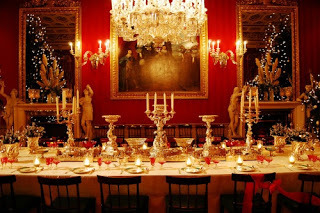 From The Book of Christmas: Descriptive of the Customs, Ceremonies, Traditions ... By Thomas Kibble Hervey (1845)
From The Book of Christmas: Descriptive of the Customs, Ceremonies, Traditions ... By Thomas Kibble Hervey (1845)Everywhere, throughout the British isles, Christmas-eve is marked by an increased activity about the good things of this life. "Now," says Stevenson, an old writer whom we have already quoted, for the customs of Charles the Second's time, "capons and hens, besides turkeys, geese, ducks, with beef and mutton, must all die; for in twelve days, a multitude of people will not be fed a little;"—and the preparations, in this respect, of this present period of grace, are made much after the ancient prescription of Stevenson. The abundant displays of every kind of edible, in the London markets, on Christmas-eve, with a view to the twelve days' festival, of which it is the overture—the blaze of lights amid which they are exhibited, and the evergreen decorations by which they are empowered —together with the crowds of idlers or of purchasers that wander through these well-stored magazines—present a picture of abundance, and a congress of faces, well worthy of a single visit from the stranger, to whom a London market, on the eve of Christmas, is, as yet, a novelty. The approach of Christmas-eve, in the metropolis, is marked by the Smithfield show of over-fed cattle; by the enormous beasts and birds, for the fattening of which medals and cups and prizes have been awarded by committees of amateur graziers and feeders ;—in honor of which monstrosities, dinners have been eaten, toasts drunk, and speeches made. These prodigious specimens of corpulency we behold, after being thus glorified, led like victims of antiquity, decked with ribands and other tokens of triumph— or perhaps, instead of led, we should, as the animals are scarcely able to waddle, have used the word goaded—to be immolated at the altar of gluttony, in celebration of Christmas! To admiring crowds, on the eve itself, are the results of oil-cake and turnip feeding displayed, in the various butchers' shops of the metropolis and its vicinity; and the efficacy of walnut-cramming is illustrated in Leadenhall market,—where Norfolk turkeys and Dorking fowls appear, in numbers and magnitude unrivalled. The average weight given for each turkey, by the statement heretofore quoted by us, of the number and gravity of those birds sentup to London from Norfolk, during two days of a Christmas, some years ago—is nearly twelve pounds; but what is called a fine bird, in Leadenhall Market, weighs, when trussed, from eighteen to one or two-and-twenty pounds,—the average price of which may be stated at twenty shillings; and prize turkeys have been known to weigh more than a quarter of a hundred weight. Brawn is another dish of this season; and is sold by the poulterers, fishmongers, and pastry-cooks. The supply for the consumption of London is chiefly derived from Canterbury, Oxfordshire, and Hampshire. "It is manufactured from the flesh of large boars, which are suffered to live in a half-wild state, and, when put up to fatten, are strapped and belted tight round the principal parts of the carcass, in order to make the flesh become dense and brawny. This article comes to market, in rolls about two feet long, and ten inches in diameter, packed in wicker baskets." Another feature of this evening, in the houses of the more wealthy, was the tall Christmas candles, with their wreaths of evergreens, which were lighted up, along with the Yule log, and placed on the upper table, or dais, of ancient days. Those of our readers who desire to light the Christmas candles, this year, may place them on the sideboard, or in any conspicuous situation. Brand, however, considers the Yule log and the Christmas candle to be but one observance—and that the former is only a substitute for the latter. By our ancestors, of the Latin church, Christmas was formerly called the " Feast of Lights "—and numbers of lights were displayed on the occasion. The lights and the title were, both, typical of the religious light dawning upon the world at that sacred period—of the advent, in fact, of the "Light of lights "—and the conquest over moral darkness. Hence, it is thought, the domestic ceremony of the Christmas candle,—and that the Yule block was but another form of the same —the poor man's Christmas candle. Our account of Christmas would not be complete,—withoutgiving some description of the forms which attended the introduction of the boar's head at the feasts of our ancestors. The boar's head soused, then, was carried into the great hall, with much state; preceded by the Master of the Revels, and followed by choristers and minstrels, singing and playing compositions in its honor. Dugdale relates that at the Inner Temple, for the first course of the Christmas dinner, was " served in, a fair and large bore's head, upon a silver platter, with minstrelsye." And here we would observe,—what we do not think has been before remarked,—that the boar's-head carols appear to have systematically consisted of three verses. A manuscript, indeed, which we once met with, stated that the "caroll, upon the bringynge in of the bore's head, was sung to the glorie of the blessed Trinytie;" and the three subsequent illustrative specimens,—in which the peculiarity mentioned may be observed,—tend to confirm this notion. At St. John's, Oxford, in 1607, before the bearer of the boar's head,—who was selected for his height and lustiness, and wore a green silk scarf, with an empty sword-scabbard dangling at his side,—went a runner, dressed in a horseman's coat, having a boar's spear in his hand,—a huntsman in green, carrying the naked and bloody sword belonging to the head-bearer's scabbard,—and "two pages in tafatye sarcenet," each with a "mess of mustard." MERRY CHRISTMAS!
Published on December 24, 2012 00:00
December 22, 2012
Dr. Syntax, Part Five (Cantos 6 and 7)
Adventures of Dr. Syntax in Search of the Picturesque Part 5
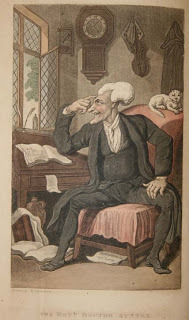 Dr. Syntax, frontispiece, by Thomas Rowlandson, 1812
Dr. Syntax, frontispiece, by Thomas Rowlandson, 1812
Excerpts from Canto VI
We left Dr. Syntax, having already survived several misadventures and not having seen anything more picturesque than a bunch of braying donkeys, has suddenly had hot water poured over his feet by accident. The maid at the inn takes care of him and invites him to stay another night, but he declines.
"...The Doctor clos'd the kind debate,
By ordering Grizzle to the gate.
Now, undisturb'd, he took his way,
And traveled till the close of day;
When, to delight his wearied eyes.
Before him Oxford's tow'rs arise.
O, Alma Mater!" Syntax cried,
My present boast, my early pride;
To whose protecting care I owe
All I've forgot, and all I know:
Deign from your nursling to receive
The homage that his heart can give! ..."
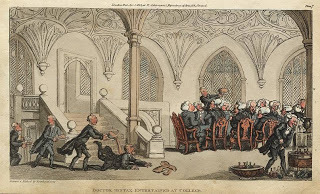 Dr. Syntax, Entertained at College, by Rowlandson
Dr. Syntax, Entertained at College, by Rowlandson
Dr. Syntax rides through Oxford, admiring the place he loves, and puts up at The Mitre for the night. Next morning, he gets a shave from the barber:
"...From him he learn'd that Dicky Bend,
His early academic friend,
As a reward for all his knowledge.
Was made the Provost of his College;
And then declared that he had clear
At least twelve hundred pounds a year.
"O ho !" says Syntax, "if that's true,
I cannot surely better do
Than further progress to delay.
And with Friend Dicky pass a day."
Away he hied, and soon he found him,
With all his many comforts round him..."
Dr. Syntax and the Provost discuss many things are enjoy their conversation:
"...At length the bell began to call
To dinner, in the college-hall;
Nor did the guests delay to meet,
Lur’d by the bounty of the treat.
The formal salutations over.
Each drew his chair and seized his cover.
The Provost, in collegiate pride,
Plac'd Doctor Syntax by his side;
And soon they heard the hurrying feet
Of those that bore the smoking meat.
Behold the dishes due appear, —
Fish in the van, beef in the rear; .."
After a friendly evening in college:
"...Next morning, at an early hour.
Syntax proceeded on his Tour;
And, as he saunter'd on his way,
The scene of many a youthful day,
He thought 'twould give his book an air,
If Oxford were well painted there;
And, as he curious look'd around,
He saw a spot of rising ground.
From whence the turrets of the city
Would make a picture very pretty.."
"...But, as he sought to choose a part.
Where he might best display his art,
A wicked bull no sooner view'd him,
Than loud he roar'd, and straight pursu'd him.
The Doctor, finding danger near,
Hew swiftly on the wings of fear,
And nimbly clamber'd up a tree,
That gave him full security..."
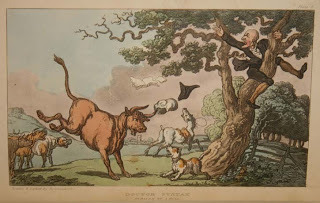 Dr. Syntax Pursued by a Bull, by Rowlandson
Dr. Syntax Pursued by a Bull, by Rowlandson
Excerpts from Canto VII
While riding onward, Dr. Syntax thinks about his wife, left behind at home...
"...though full many a year was gone.
Since this good dame was twenty-one,
She still retain'd the air and mien
Of the nice girl she once had been.
For these, and other charms beside,
She was indeed the Doctor’s pride;
Nay, he would sometimes on her gaze
With the fond looks of former days. ..."
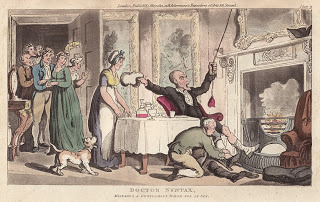 Dr. Syntax Mistakes a Gentleman's House for an Inn
Dr. Syntax Mistakes a Gentleman's House for an Inn
He meets a curate and shares a long afternoon of conversations about their mutual poverty, then rides so long that he is exhausted, As he looks for an Inn, he arrives at a Gentleman's House and makes free with his guests, servants and accommodations, another error. He addresses the Gentleman thusly:
... “Landlord! I'm sadly splash'd with mire And chill'd with rain, so light a fire;
And tell the ostler to take care
Of that good beast, my Grizzle mare;
And what your larder can afford,
Pray place it quickly on the board...."
Dr. Syntax becomes quite inebriated and, though he does not realize it, becomes the evening's entertainment for the squire and his guests, who are quite amused. The next morning, over breakfast, the good doctor learns of the jest.
"...At length the 'Squire explained the joke;
When thus the Doctor quaintly spoke: —
" I beg, Sir, no excuse you'll make,
Your merriment I kindly take;
And only wish the gods would give
Such jesting ev'ry day I live."
The ladies press'd his longer stay,
But Syntax said — he must away.
So Grizzle soon her master bore,
Some new adventure to explore. "
End of Canto VII
 Dr. Syntax, frontispiece, by Thomas Rowlandson, 1812
Dr. Syntax, frontispiece, by Thomas Rowlandson, 1812Excerpts from Canto VI
We left Dr. Syntax, having already survived several misadventures and not having seen anything more picturesque than a bunch of braying donkeys, has suddenly had hot water poured over his feet by accident. The maid at the inn takes care of him and invites him to stay another night, but he declines.
"...The Doctor clos'd the kind debate,
By ordering Grizzle to the gate.
Now, undisturb'd, he took his way,
And traveled till the close of day;
When, to delight his wearied eyes.
Before him Oxford's tow'rs arise.
O, Alma Mater!" Syntax cried,
My present boast, my early pride;
To whose protecting care I owe
All I've forgot, and all I know:
Deign from your nursling to receive
The homage that his heart can give! ..."
 Dr. Syntax, Entertained at College, by Rowlandson
Dr. Syntax, Entertained at College, by RowlandsonDr. Syntax rides through Oxford, admiring the place he loves, and puts up at The Mitre for the night. Next morning, he gets a shave from the barber:
"...From him he learn'd that Dicky Bend,
His early academic friend,
As a reward for all his knowledge.
Was made the Provost of his College;
And then declared that he had clear
At least twelve hundred pounds a year.
"O ho !" says Syntax, "if that's true,
I cannot surely better do
Than further progress to delay.
And with Friend Dicky pass a day."
Away he hied, and soon he found him,
With all his many comforts round him..."
Dr. Syntax and the Provost discuss many things are enjoy their conversation:
"...At length the bell began to call
To dinner, in the college-hall;
Nor did the guests delay to meet,
Lur’d by the bounty of the treat.
The formal salutations over.
Each drew his chair and seized his cover.
The Provost, in collegiate pride,
Plac'd Doctor Syntax by his side;
And soon they heard the hurrying feet
Of those that bore the smoking meat.
Behold the dishes due appear, —
Fish in the van, beef in the rear; .."
After a friendly evening in college:
"...Next morning, at an early hour.
Syntax proceeded on his Tour;
And, as he saunter'd on his way,
The scene of many a youthful day,
He thought 'twould give his book an air,
If Oxford were well painted there;
And, as he curious look'd around,
He saw a spot of rising ground.
From whence the turrets of the city
Would make a picture very pretty.."
"...But, as he sought to choose a part.
Where he might best display his art,
A wicked bull no sooner view'd him,
Than loud he roar'd, and straight pursu'd him.
The Doctor, finding danger near,
Hew swiftly on the wings of fear,
And nimbly clamber'd up a tree,
That gave him full security..."
 Dr. Syntax Pursued by a Bull, by Rowlandson
Dr. Syntax Pursued by a Bull, by RowlandsonExcerpts from Canto VII
While riding onward, Dr. Syntax thinks about his wife, left behind at home...
"...though full many a year was gone.
Since this good dame was twenty-one,
She still retain'd the air and mien
Of the nice girl she once had been.
For these, and other charms beside,
She was indeed the Doctor’s pride;
Nay, he would sometimes on her gaze
With the fond looks of former days. ..."
 Dr. Syntax Mistakes a Gentleman's House for an Inn
Dr. Syntax Mistakes a Gentleman's House for an InnHe meets a curate and shares a long afternoon of conversations about their mutual poverty, then rides so long that he is exhausted, As he looks for an Inn, he arrives at a Gentleman's House and makes free with his guests, servants and accommodations, another error. He addresses the Gentleman thusly:
... “Landlord! I'm sadly splash'd with mire And chill'd with rain, so light a fire;
And tell the ostler to take care
Of that good beast, my Grizzle mare;
And what your larder can afford,
Pray place it quickly on the board...."
Dr. Syntax becomes quite inebriated and, though he does not realize it, becomes the evening's entertainment for the squire and his guests, who are quite amused. The next morning, over breakfast, the good doctor learns of the jest.
"...At length the 'Squire explained the joke;
When thus the Doctor quaintly spoke: —
" I beg, Sir, no excuse you'll make,
Your merriment I kindly take;
And only wish the gods would give
Such jesting ev'ry day I live."
The ladies press'd his longer stay,
But Syntax said — he must away.
So Grizzle soon her master bore,
Some new adventure to explore. "
End of Canto VII
Published on December 22, 2012 01:00
December 20, 2012
A Couple In England - Windsor
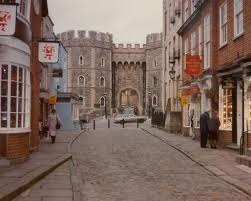
As you probably know by now, my Husband, who is accompanying me on my trip to England in a week, is not a history buff, nor is he very good at playing tourist. I have been trying my best to add items to our London and Bath itineraries that he will also enjoy and don't mind telling you that it's been a hard slog. Therefore, when it came time to plan our stay in Windsor, the final leg of our trip, I gave up any pretence of pretending that this entire trip wasn't designed for my sole pleasure and have crafted an itinerary sure to make my Husband's head spin, whilst no doubt making his feet hurt. You may recall that Victoria, Jo Manning and I have a good friend who lives in Windsor, the author Hester Davenport. Who has actually met the Queen, I might add. You can read all about it here. Last time Vicky and I were in Windsor with Hester, we toured the Castle and visited the grave of Mary Robinson, mistress of George IV, about whom Hester has written a biography.
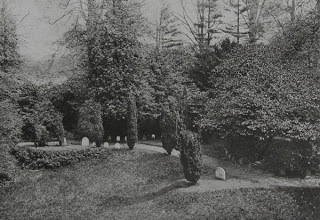
This time out, Hester and I have been fiendishly crafting an itinerary to gladden any history buff's heart. No matter that it is guaranteed, at the same time, to send Hubby off the deep end. We shall be visiting the Windsor and Royal Borough Museum, which Hester has played a part in developing, and will then again be touring Windsor Castle. This time out, we will also be taking a rarely open tour of the royal kitchens, something we are both looking forward to seeing. And I'll get to see this magnificent portrait of the Duke of Wellington that hangs in the Castle again.
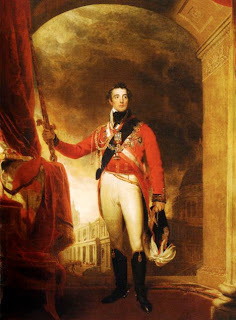
Next day, we'll be driving to Oatlands in order to visit the pet cemetery of Frederica, Duchess of York, pictured above in black and white. Naturally, Hester and I are both excited about this stop - I can only imagine what Hubby's reaction will be . . . . Then it's on to Hampton Court Palace, a place I have never seen, if you can believe it. I'm especially interested in seeing Apartment 8, where the Duke of Wellington's sister, Lady Anne Smith, lived.
No doubt Hubby will opt out of certain of the aforementioned entertainments. Unfortunatley, the thing he can't opt out of is our nine hour flight home, followed by a seven hour layover in Newark, and then another flight to Florida. We'll be leaving England at ten a.m. and not landing in Florida until 11 p.m. - a total of 18 hours travel time. Hubby, naturally, has no idea what he's in for, as I've decided not to spoil the trip by telling him in advance what fate awaits. Have I mentioned that he has a bad back? Reader, it won't be pretty. So, while I'm looking forward to the trip, at the same time I'm dreading our return journey. I can't help but think that January 5th, 2013 will be the date of my very own Waterloo. . . . . to be continued (one hopes).
Published on December 20, 2012 00:00
December 18, 2012
Believe It or Not, Regency Version
From The Annual Register for 1811, Chronicle, p. 140-141
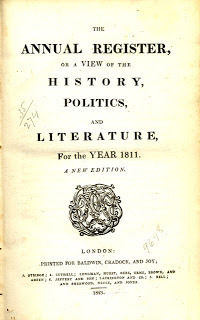
December 19, 1811
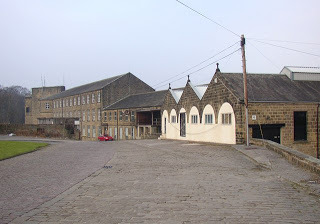 Greenholme Mill, Yorkshire
Greenholme Mill, Yorkshire
“A girl named Martha Stowell, working at a mill at Greenholme, Yorkshire, crossing an adjoining field, slipped and dislocated, or otherwise injured her hip.
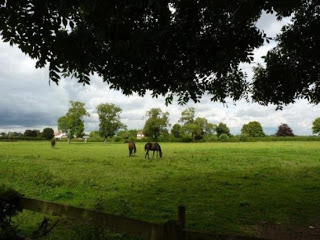 Greenholme Close
Greenholme Close
She was rendered lame and unable to work, and continued in that state for week when her uncle came to fetch her home.
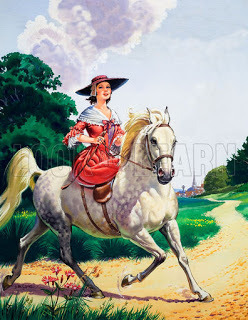 picture by J. B. Long
picture by J. B. Long
On her way, riding a single horse between Burley and Ilkley, she met a gig upon the road, at which her horse took fright, threw her, and dragged her a short distance in the stirrup; when disengaged, she got up, and it is added, to the great surprise of herself and her uncle, found herself quite well, and being perfectly able to walk, returned to her work.
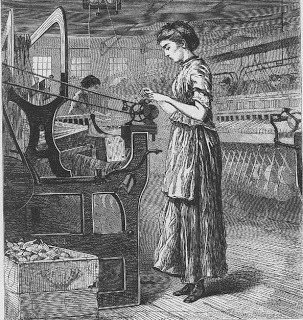 Bobbin Girl by Winslow Homer
Bobbin Girl by Winslow Homer
So, do you believe the story, that the hip was slipped back into place? And, have you ever fallen off a horse??? Were you hurt?
Victoria says she has fallen off many times, been nipped, stamped on and kicked at, but, since she was near a horse, it NEVER hurt. She also says she had lots of lovely rides, many loving nuzzles and lots of quality time with her equine friends. Are you a horse lover?
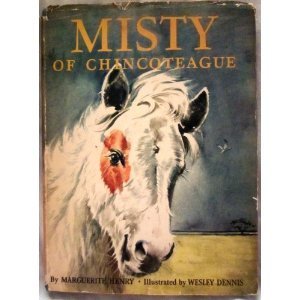 An old favorite by Marguerite Henry with superb pictures by Wesley Dennis
An old favorite by Marguerite Henry with superb pictures by Wesley Dennis

December 19, 1811
 Greenholme Mill, Yorkshire
Greenholme Mill, Yorkshire“A girl named Martha Stowell, working at a mill at Greenholme, Yorkshire, crossing an adjoining field, slipped and dislocated, or otherwise injured her hip.
 Greenholme Close
Greenholme CloseShe was rendered lame and unable to work, and continued in that state for week when her uncle came to fetch her home.
 picture by J. B. Long
picture by J. B. LongOn her way, riding a single horse between Burley and Ilkley, she met a gig upon the road, at which her horse took fright, threw her, and dragged her a short distance in the stirrup; when disengaged, she got up, and it is added, to the great surprise of herself and her uncle, found herself quite well, and being perfectly able to walk, returned to her work.
 Bobbin Girl by Winslow Homer
Bobbin Girl by Winslow HomerSo, do you believe the story, that the hip was slipped back into place? And, have you ever fallen off a horse??? Were you hurt?
Victoria says she has fallen off many times, been nipped, stamped on and kicked at, but, since she was near a horse, it NEVER hurt. She also says she had lots of lovely rides, many loving nuzzles and lots of quality time with her equine friends. Are you a horse lover?
 An old favorite by Marguerite Henry with superb pictures by Wesley Dennis
An old favorite by Marguerite Henry with superb pictures by Wesley Dennis
Published on December 18, 2012 01:00
December 16, 2012
Happy Birthday, Jane Austen
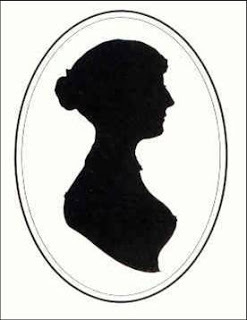 16 December, 1775 - 16 July, 1817
16 December, 1775 - 16 July, 1817In her brief 41 years and in only six complete novels, some juvenilia, unfinished works, a few poems and letters, Jane Austen provided us with enough material to fascinate generations of readers, admirers, scholars, and assorted experts. Not to mention film and television series producers and sequel-writers.
Victoria here, just back from a luncheon celebrating the 237th anniversary of Jane Austen's birth. Last week, I attended a tea in honor of the same event presented by the Chicago region of JASNA at the Fortnightly.
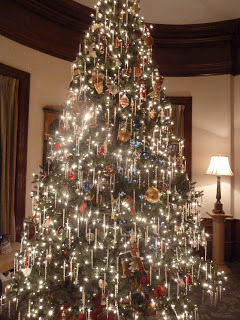 Christmas Tree at Chicago's Fortnightly
Christmas Tree at Chicago's Fortnightly Lucia Mauro of Loyola University spoke on "Social Dance in Jane Austen's Time," tracing the history and significance of the various types of dance in the regency era. As always, a full house enjoyed both the talk and the lovely tea.
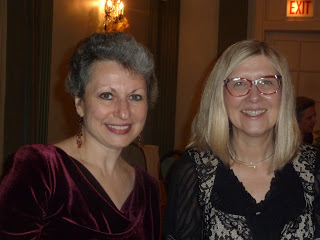 Lucia Mauro, left, and Elisabeth Lenckos, JASNA-GCR Program Chair
Lucia Mauro, left, and Elisabeth Lenckos, JASNA-GCR Program Chair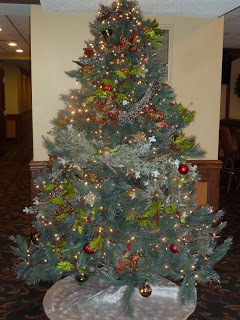 Celebrating Jane Austen's birthday at festive North Hills Country Club
Celebrating Jane Austen's birthday at festive North Hills Country ClubThe Wisconsin region of JASNA held a gala luncheon on December 15 at beautiful North Hills, where we toasted our Jane and ate delicious Beef Wellington. Yum. Trifle for dessert.
Our speaker, Emily Auerbach, professor of English at UW-Madison gave a most entertaining presentation drawn from her research for a chapter of the Cambridge University Press's upcoming Companion to Pride and Prejudice, to be published in the summer of 2013. Entitled "Pride, Prejudice, and Proliferationn: Sequels, Prequels, Mash-ups, Adaptations, and Permutations," her talk presented a partial view of 200 years of continuations, etc. of Pride and Prejudice. She explained that no sooner did she update a draft of the chapter than new versions appear, an extraordinary number of variations that testify to Jane Austen as her own "BRAND." It is, she said, a compliment to Austen's universal characters and the power of her sparkling novel.
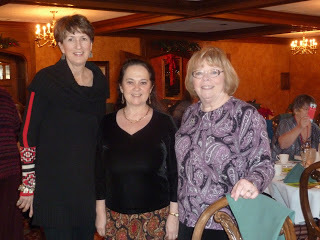 from left, Liz Cooper, outgoing regional chair; Emily Auerbach; and Judy Beine, incoming chair
from left, Liz Cooper, outgoing regional chair; Emily Auerbach; and Judy Beine, incoming chairIn a few days, 2013 begins, marking 200 years since Miss Austen published Pride and Prejudice, probably her most beloved novel. It leads the pack in terms of plays, movies, tv versions, sequels and prequels, and adaptations into other time periods and cultures. I intend to attend many events to mark that anniversary too. I hope you will find an event -- whether a talk, a tea or a garden tour to celebrate too. Check out www.jasna.org to see what is offered. Next year's AGM is in Minneapolis, Minnesota, September 27-29, 2013. The theme is Jane Austen's Pride and Prejudice...Timeless.
And if you can't find an event in your back yard, participate online:
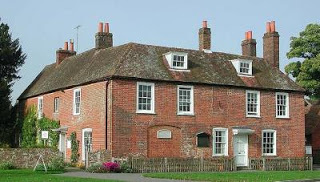 Jane Austen's House Museumhttp://www.jane-austens-house-museum.org.uk/
Jane Austen's House Museumhttp://www.jane-austens-house-museum.org.uk/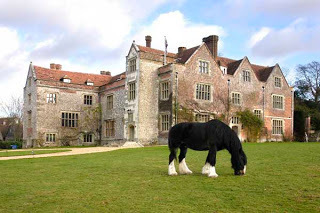 Chawton House Libraryhttp://www.chawtonhouse.org/
Chawton House Libraryhttp://www.chawtonhouse.org/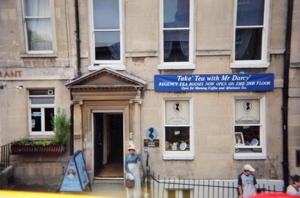 Jane Austen Center, Bathhttp://www.janeausten.co.uk/
Jane Austen Center, Bathhttp://www.janeausten.co.uk/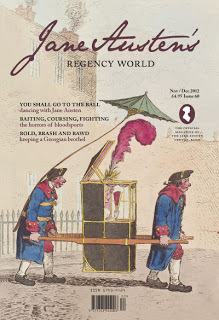 Jane Austen's Regency World magazinehttp://janeaustenmagazine.co.uk/
Jane Austen's Regency World magazinehttp://janeaustenmagazine.co.uk/
Published on December 16, 2012 01:00
December 14, 2012
Rembrandt, Van Dyck, Gainsborough: The Treasures of Kenwood House, London
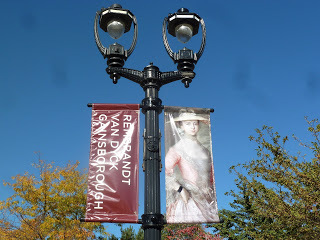
The Milwaukee Art Museum is showing Rembrandt, Van Dyck, Gainsborough: The Treasures of Kenwood House, London through January 13, 2013. Victoria here, reporting about my several visits to this outstanding exhibition. I wrote about it previously here. And I have attended a number of programs associated with the exhibition.
Curator of the exhibition, Dr. Susan Jenkins, is a senior curator at Kenwood House for English Heritage, the British government’s agency administering hundreds of historical sites, from Stonehenge to Cold War nuclear missile sites. She trained at London’s Courtauld Institute and previously served as a curator at Apsley House, the Wellington Museum.
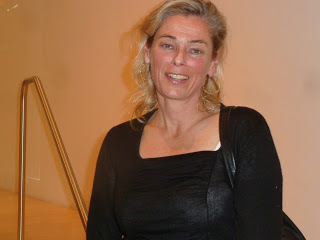 Susan Jenkins
Susan JenkinsFour particular interests of Lord Iveagh guided his choice of paintings and these four are used to arrange the paintings at the MAM. They are: Dutch and Flemish artworks, long valued by the British aristocracy; Portraits of Women, particularly by the great 18th century British portraitists; Portrayals of Children; and Landscapes and Maritime pictures.
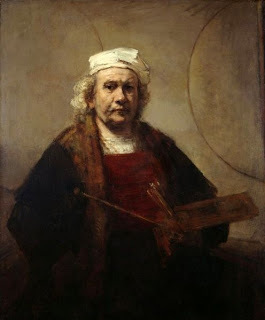 Rembrandt van Rijn, Portrait of the Artist, ca. 1665
Rembrandt van Rijn, Portrait of the Artist, ca. 1665Foremost in the first group is, of course, Portrait of the Artist, 1665, by Rembrandt van Rijn, among many other outstanding works by Van Dyke, Hals, and others.
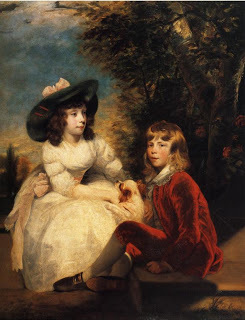 Joshua Reynolds, The Angerstein Children, ca. 1782-85
Joshua Reynolds, The Angerstein Children, ca. 1782-85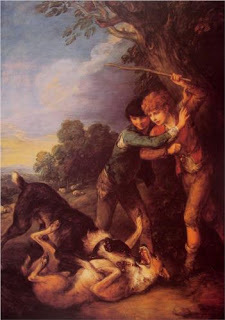 Thomas Gainsborough, Two Shepherd Boys with Dogs Fighting, 1783
Thomas Gainsborough, Two Shepherd Boys with Dogs Fighting, 1783The children’s portraits vary widely from the skipping miss of Sir Thomas Lawrence to the dramatic candlelit image by Joseph Wright of Derby.
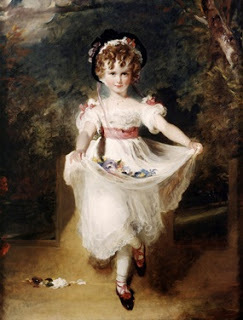 Sir Thomas Lawrence, Miss Murray, 1824-26
Sir Thomas Lawrence, Miss Murray, 1824-26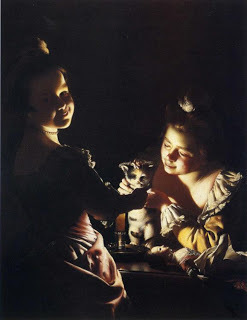 Joseph Wright of Derby, Two Girls Dressing a Kitten by Candlelight, ca. 1768-70
Joseph Wright of Derby, Two Girls Dressing a Kitten by Candlelight, ca. 1768-70Among the landscapes and maritime works is one of Joseph Mallord William Turner’s early seascapes which foreshadowed his later dramatic and unique techniques.
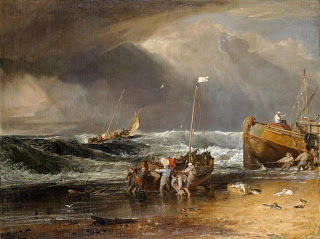 Joseph Mallord William Turner, A Coastal Scene with Fishermen Hauling a Boat Ashore("The Iveagh Sea-Piece"), ca. 1803-04
Joseph Mallord William Turner, A Coastal Scene with Fishermen Hauling a Boat Ashore("The Iveagh Sea-Piece"), ca. 1803-04The erudite Christopher Lloyd spoke on "Contrasts in Royal Patronage: Sir Joshua Reynolds and Thomas Gainsborough." Mr. Lloyd is the former Surveyor of the Queen’s Pictures (the Royal Collection, www.royalcollection.org.uk) and served as Guest Curator for the MAM’s exhibition Impressionism: Masterworks on Paper, one year ago.
Mr. Lloyd characterized the personalities and gifts of Sir Joshua Reynolds (1723 – 1792) and Thomas Gainsborough (1727-1788), a study in contrasts. Though both came from modest beginnings in the country, their approaches to their work could hardly have been different. Though both excelled at portraiture, they held entirely different attitudes toward the theory and practice of painting. Reynolds, founding president of the Royal Society of Art, was the ultimate insider, friend and colleague of the greatest men in literature, government and society. He studied and followed traditional methodology and utilized classical ideals by which to organize his works. Mr. Lloyd recommended reading Reynolds’ collected lectures on the theory and practice of painting, Discourses on Art.
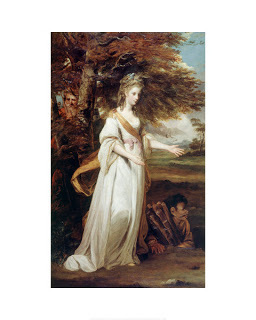 Joshua Reynolds, Mrs. Tollemarche as "Miranda", 1773-74
Joshua Reynolds, Mrs. Tollemarche as "Miranda", 1773-74Gainsborough, said Mr. Lloyd, was an outsider, on the edges of the art establishment, always (in today’s terminology) pushing the envelope when it came to poses, techniques and even subject matter, though his popular portraits financed his life. Where Joshua Reynolds was official portrait painter to King George III, Gainsborough was more likely to favor – and be favored by – the raffish circle of George, Prince of Wales, who disagreed with his father on everything: his behavior, his friends and his taste in art.
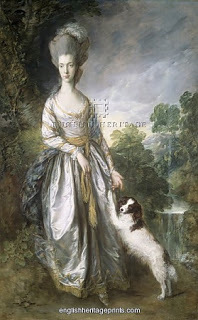 Thomas Gainsborough, Lady Brisco, ca. 1776
Thomas Gainsborough, Lady Brisco, ca. 1776Reynolds and Gainsborough definitely were rivals though when the latter was nearing death, Reynolds reconciled with him and praised Gainsborough’s achievements. They were men of great, but very different, skills and temperaments. Mr. Lloyd suggested that visitors to the exhibition look for the great contrasts in the styles and techniques of the two artists; Six pictures by Gainsborough and nine by Reynolds are on display.
The exhibition Rembrandt, Van Dyck and Gainsborough: The Treasures from Kenwood House is organized by The American Federation of Art and English Heritage. After it closes in Milwaukee in January, 2013, it will travel to Seattle and Arkansas.
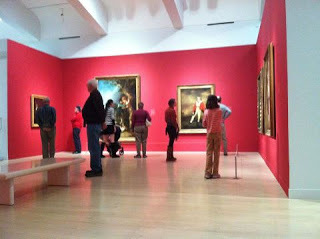 Milwaukee Art Museum
Milwaukee Art Museum
Published on December 14, 2012 01:00
December 12, 2012
Dr. Syntax, Part Four (Cantos 4 and 5)
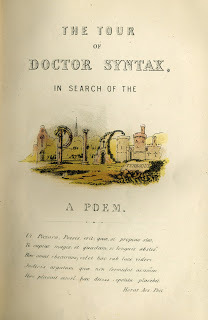
More from The Tour of Dr. Syntax in Search of the PicturesqueIn Canto I, Syntax conceives his project and takes off on his quest on his mare Grizzle, leaving his wife behind. Canto II finds Syntax confronting, instead of a sublime scene of wild beauty, a pack of braying donkeys. As he mourns the scene, he is attacked by highwaymen who steal his purse and his mare, leaving the poor Syntax tied to a tree.
He is rescued in Canto Three and remembers his good wife had sewn some of his money into his clothes, so he is not without funds. He finds his way to an inn and Grizzle is found, though the poor horse has had her ears and tail docked.
Excerpts from Canto IV
He finds sleep in the inn refreshing:
…Thus wrapt in slumber Syntax lay —
Forgot the troubles of the day:
So sound his sleep, so sweet his rest.
By no disturbing dreams distrest;
That, all at ease, he lay entranced.
Till the fair morn was far advanc'd. …
After his morning ablutions and a hearty breakfast…
"...And when the well-fed meal was o'er,
Grizzle was order'd to the door;
Betty was also told to say.
The mighty sum there was to pay:
Betty, obedient to his will,
Her court'sy makes, and brings the bill.
Down the long page he cast his eye,
Then shook his head, and heav'd a sigh,
"What! am I doom'd, where'er I go.
In all I meet to find a foe?
Where'er I wander, to be cheated.
To be bamboozled and ill-treated!"
Thus, as he read each item o'er,
The hostess op'd the parlour door;
When Syntax 'rose in solemn state.
And thus began the fierce debate:—
“Good woman; here, your bill retake,
And, prithee, some abatement make;
I could not such demands afford. …
Were I a bishop or a lord.”
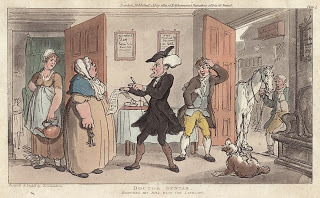 Dr. Syntax Disputing his Bill with the Landlady
Dr. Syntax Disputing his Bill with the Landlady… Hostess: "The charges all are fairly made;
If you will eat, I must be paid.
My bills have never found reproaches
From lords and ladies, in their coaches...”
Finally Dr. Syntax makes an offer:
“I'm in haste to get away,
Though one pound three I will not pay:
So, if you'll take one-half th' amount,
We'll quickly settle the account.
There is your money — do you see ?
And let us part in charity."
The hostess agrees, and Canto IV ends with Dr. Syntax waiting for his mare, Grizzle..
Excerpts from Canto V:Once on his way, Dr. Syntax reflects on his quest.
“It seems to be my luckless case.
At ev'ry point, in every place.
To meet with trouble and disgrace.
But yesterday I left my home.
In search of fancied wealth to roam;
And nought, I think, but ills betide me
Sure, some foul spirit runs beside me;
Some blasting demon from the east,
A deadly foe to man and beast.
That loves to riot in disaster,
And plague alike both horse and master.”
Dr. Syntax seeks out some help for his horse’s wounds, and once she is treated, goes on to stay at another inn. The next morning he goes down for breakfast.
“In spirits from his calm repose;
And while the maid prepar'd the tea,
He look'd around the room to see
What story did the walls disclose
Of human joys, of human woes.
The window quickly caught his eye,
On whose clear panes he could descry
The motley works of many a Muse:
There was enough to pick and choose;
And, "Faith!" said he, "to strive to hook
Some of these lines into my book:
For here there are both grave and witty,
And some, I see, are rather pretty."
From a small pocket in his coat
He drew his tablets, — when he wrote
Whate'er the pregnant panes possess'd;
And these choice lays among the rest:
’If my fond breast were made of glass.
And you could see what there doth pass,
Kitty, my ever charming fair!
You'd see your own sweet image there.’" ...
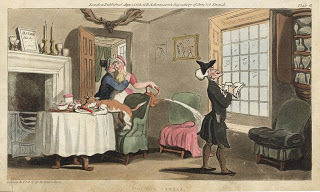 Dr. Syntax Copying the Wit of the Window
Dr. Syntax Copying the Wit of the WindowAfter copying down several more of these stories,
“...But as he copied, quite delighted,
All that the Muse had thus indited,
A hungry dog, and prone to steal.
Ban off with half his breakfast meal;
While Dolly, ent'ring with a kettle.
Was follow'd by a man of mettle.
Who swore he’d have the promis'd kiss;
And, as he seiz'd the melting bliss,
From the hot, ill-pois'd kettle's spout,
The boiling stream came pouring out.
Which drove the Doctor from the Muse,
By quickly filling both his shoes.”
Canto V ends with poor Dr. Syntax suffering yet another affront: his shoes are steaming!
To be continued soon....
Published on December 12, 2012 01:00
December 10, 2012
A Couple In England: Bound For Bath
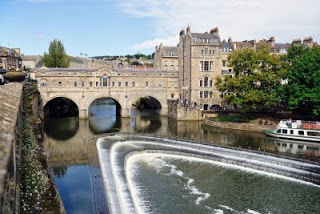
As I write this, the news is filled with reports of floods, cold snaps and even snow in the UK. However, my heart is warmed by the thought of returning to Bath, one of my favourite cities. Bath stone, Georgian architecture and Regency reminders on virtually every street. As you may know, my Husband is a reluctant tourist. Our most recent discussion about the Bath portion of our trip went something like this:
Him - We don't have to be doing something every minute of every day.
Me - Mmmmmmm.
Him - What's there to do in Bath, anyway?
Me - Well . . . . there are the Roman baths and the Assembly Rooms and the Holburne Museum and the ice rink and the Royal Crescent. And, er, the Fashion Museum.
Him - (Groan, eye roll, deep sigh) Remember that I'm old and have a bad back, will ya? I can't keep going and going every day like you.
Me - You're not that old. You're only four years older than me.
Him - Yeah, but you're actually interested in British history and you don't have a bad back.
Point taken. But it's Bath. Our hotel is in walking distance of Pulteney Bridge (above) and the Abbey and I must admit to having splurged on this portion of our trip - we are booked into the Wellington Suite for the duration - sitting room, bedroom and bathroom with a tub big enough for a right proper soaking. So far, in addition to those items listed above, our itinerary for the three days in Bath includes a bus tour of the City, a stroll of the streets of Bath, a trip to Longleat House for the Christmas extravaganza, some shopping, some pub hopping, a horse and carriage ride, New Year's Eve dinner followed by fireworks over the Abbey and finally a New Year's day trip to a nearby spa for two hours of couples pampering. I mean, one must spa when in a spa town, non?
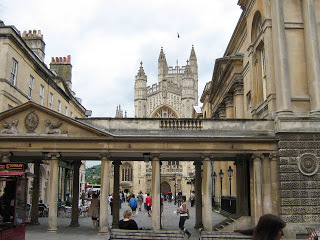
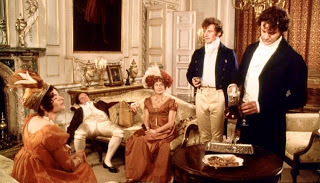
The only dark spot on the Bath horizon (aside from a grumbling husband) is that the City won't be filled with people dressed in period costume. Note to self: attend Jane Austen Festival one year soon. When I think of Bath, I think of Mrs. Delaney and Jane Austen, Beau Nash and liveried footmen. It's a bit of shock to arrive to find the streets populated instead with 21st century people dressed in down jackets, button down shirts and jeans and not a single gleaming brass button in sight.
Upon taking a really good look at our itinerary, I admit it may seem a tad crowded. Ish. And Hubby might have cause to gripe at having to take the train, and then a taxi, to Longleat. And having been at Longleat all day long visiting the house, Christmas displays and perhaps even the safari park, Hubby might not be in the mood to return to the hotel, get all spruced up in order to go out for dinner and then stay up until midnight to watch the fireworks display. The phrase "going and going" comes to mind, but, hey, things could be worse for the Husband. At least I'm not expecting him to dress like Colin Firth.
Published on December 10, 2012 00:30
December 8, 2012
The Wellington Connection - Count D'Orsay
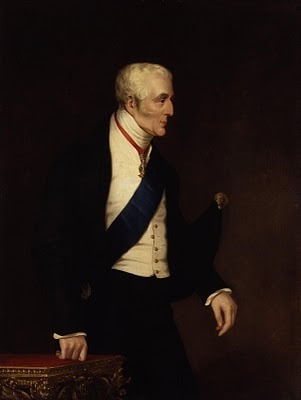 Arthur Wellesley, 1st Duke of Wellington, by Alfred, Count D'Orsay
Arthur Wellesley, 1st Duke of Wellington, by Alfred, Count D'OrsayWhilst the Duke of Wellington approved of elegance and was himself known as "the Beau," he felt obliged to advise his splendidly uniformed Grenadier Guards that their behavior was "not only ridiculous but unmilitary" when they rode into battle on a rainy day with their umbrellas raised. A dandy Wellington was not. Odd, then, that one of the pictures of himself that Wellington liked most was one done by one of the greatest dandies of his day - Count D'Orsay. D'Orsay sketched the Duke in profile (above), in evening dress, and the Duke is said to have rather liked the picture, because it "made him look like a gentleman." Count Albert Guillaume d’Orsay, the son of one of Napoleon’s generals, and descended by a morganatic marriage from the King of Wurttemburg was himself a gentleman in every sense, and his courtesy was of the highest kind. At the balls given by his regiment, although he was more courted than any other officer, he always sought out the plainest girls and showed them the most flattering attentions. During his firsts visit to London, Count d’Orsay was invited once or twice to receptions given by the Earl and Countess of Blessington, where he was well received, though this was only an incident of his English sojourn. Before the story proceeds any further it is necessary to give an account of the Earl and of Lady Blessington, since both of their careers had been, to say the least, unusual.
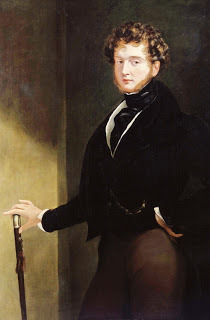
Lord Blessington was an Irish peer for whom an ancient title had been revived. He was remotely descended from the Stuarts of Scotland, and therefore had royal blood to boast of. He had been well educated, and in many ways was a man of pleasing manner. On the other hand, he had early inherited a very large property which yielded him an income of about thirty thousand pounds a year. He had estates in Ireland, and he owned nearly the whole of a fashionable street in London, with the buildings erected on it. Thrown together by the same society and so often in each other's company, the Earl of Blessington became as devoted to D’Orsay as did his wife. The two urged the Count to secure a leave of absence and to accompany them to Italy. This he was easily persuaded to do; and the three passed weeks and months of a languorous and alluring intercourse among the lakes and the seductive influence of romantic Italy. Just what passed between Count d’Orsay and Margaret Blessington at this time cannot be known, for the secret of it has perished with them; but it is certain that before very long they came to know that each was indispensable to the other.
The situation was complicated by the Earl of Blessington, who, entirely unsuspicious, proposed that the Count should marry Lady Harriet Gardiner, his eldest legitimate daughter by his first wife. He pressed the match upon the embarrassed D’Orsay, and offered to settle the sum of forty thousand pounds upon the bride. The girl was less than fifteen years of age. She had no gifts either of beauty or of intelligence; and, in addition, D’Orsay was now deeply in love with her stepmother.
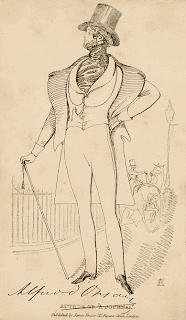 Count D'Orsay, self portrait But once again I digress. Suffice it to say that eventually Lady Blessington and the Count set up a home together, both in London, at Gore House, and in Paris, where Lady Blessington died. Upon her death, andbefore when they found themselves in straightened financial waters, the Count drew upon his artistic talents, both in painting and sculpture, in order to earn money. Whatever one thought about the Count personally, no one could deny his artistic talent. D'Orsay would go on to produce a painting of Gore House, of which I can find no image to use here. Instead, I give you a comtemporary print of Gore House -
Count D'Orsay, self portrait But once again I digress. Suffice it to say that eventually Lady Blessington and the Count set up a home together, both in London, at Gore House, and in Paris, where Lady Blessington died. Upon her death, andbefore when they found themselves in straightened financial waters, the Count drew upon his artistic talents, both in painting and sculpture, in order to earn money. Whatever one thought about the Count personally, no one could deny his artistic talent. D'Orsay would go on to produce a painting of Gore House, of which I can find no image to use here. Instead, I give you a comtemporary print of Gore House -
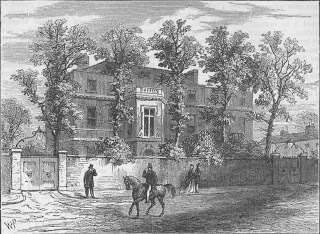 And the description of D'Orsay's painting, which illustrates the illustrious circles D'Orsay found himself within and also brings us back to the Duke of Wellington -
And the description of D'Orsay's painting, which illustrates the illustrious circles D'Orsay found himself within and also brings us back to the Duke of Wellington - "A garden view of Gore House, the residence of the late Countess of Blessington, with Portraits of the Duke of Wellington, Lady Blessington, the Earl of Chesterfield, Sir Edwin Landseer, Count D'Orsay, the Marquis of Douro (2nd Duke of Wellington), Lord Brougham, the Misses Power, etc. In the foreground, to the right, are the Duke of Wellington and the Countess of Blessington; in the centre, Sir Edwin Landseer seated, who is in the act of sketching a very fine cow, which is standing in front, with a calf by its side, while Count D'Orsay, with two favorite dogs, is seen on the right of the group, and the Earl of Chesterfield on the left; nearer the house, the two Misses Power (nieces of Lady Blessington) are reading a letter, a gentleman walking behind. Further to the left appear Lord Brougham, the Marquis of Douro, etc., seated under a tree in conversation."
Published on December 08, 2012 00:30
Kristine Hughes's Blog
- Kristine Hughes's profile
- 6 followers
Kristine Hughes isn't a Goodreads Author
(yet),
but they
do have a blog,
so here are some recent posts imported from
their feed.



